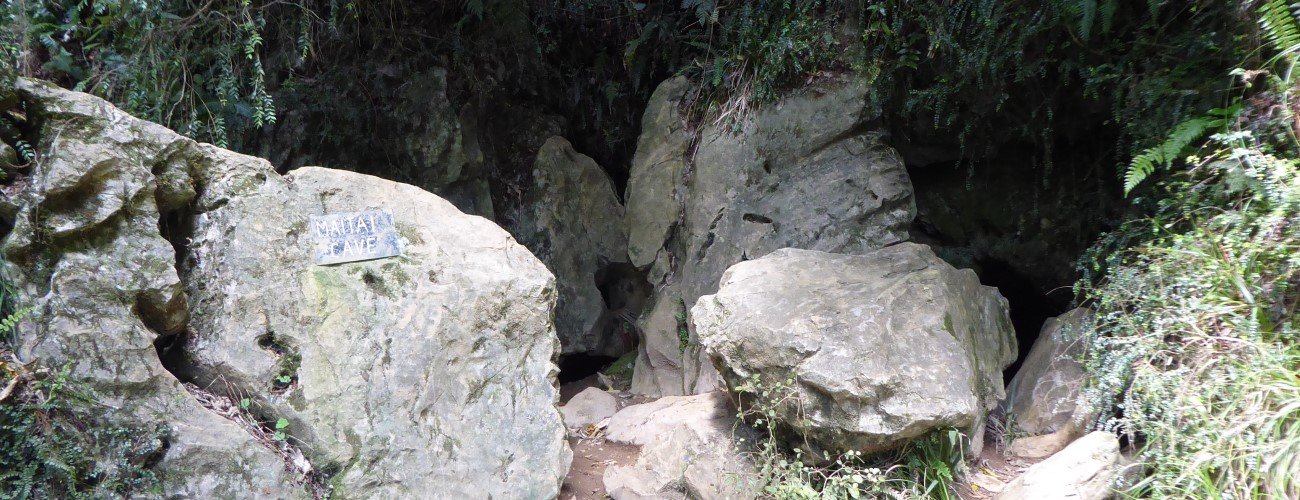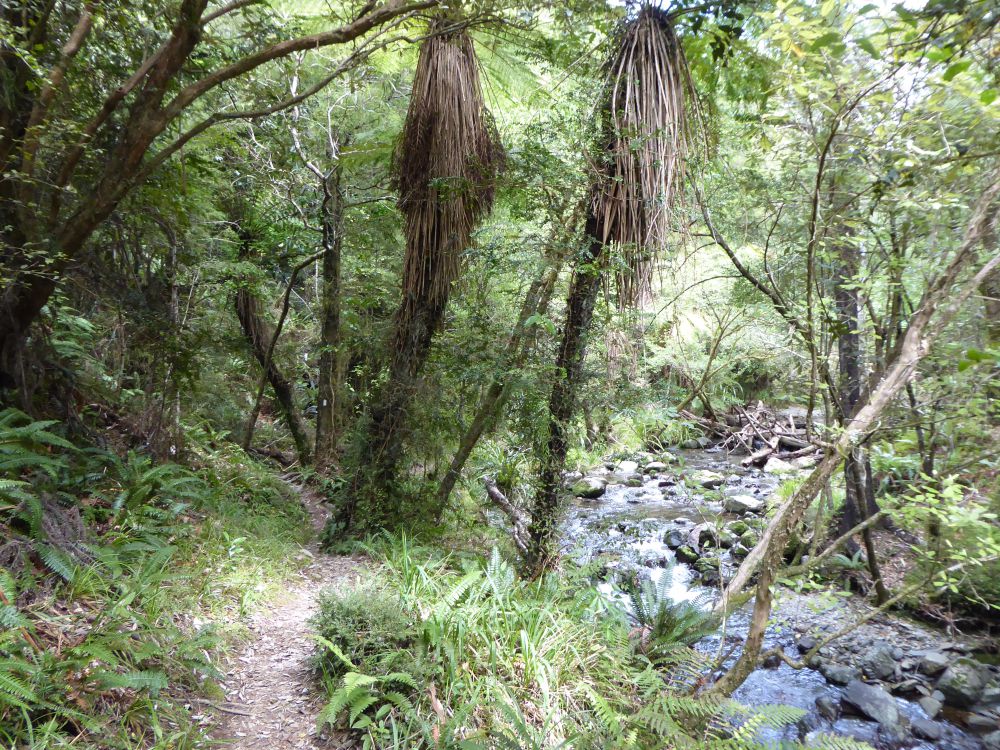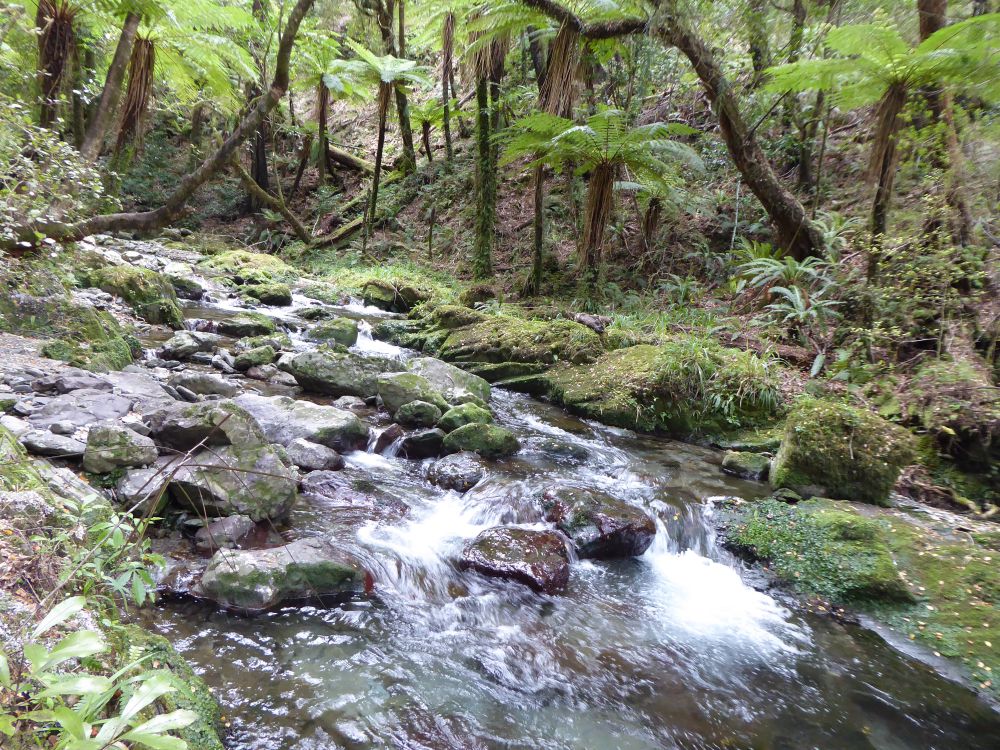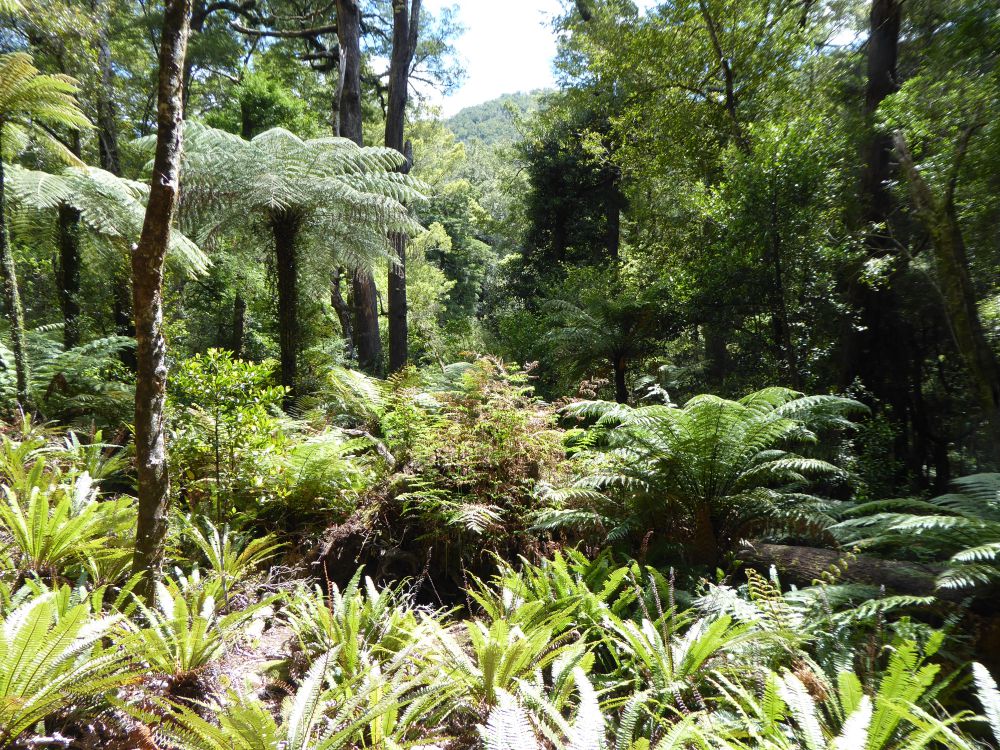
Maitai Cave is a small cave in the upper Maitai Valley, southeast of central Nelson. The track to the cave branches off Coppermine Trail and passes through stunning mixed beech and podocarp forest, with the pristine Sclanders Creek flowing alongside. The cave offers a good introduction to cave exploration for young children, and the track makes for a good bushwalk regardless of the cave. For geological context, the cave is part of the Wooded Peak limestone formation, a belt of limestone that runs northeast to southwest through Mt Richmond Forest Park, parallel to the mineral belt. The area is protected in Nelson City Council’s Maitai Water Reserve.
| Details | |
| Length | 10.4 km return from Maitai Dam; 3.3 km return from Coppermine Trail turnoff |
| Time Required | 3 hr return |
| Trail Type | Walking track |
| Physical Difficulty | Moderate |
| Uses | Walking |
| Direction | Return (out and back) |
| Start Elevation | 120 m |
| Max Elevation | 340 m (cave entrance) |
| Dog Access | Dogs are prohibited in Maitai Water Reserve |
| Note | Bring a torch with you if you intend to enter the cave |
If any layers fail to load, try clearing your cache and refreshing the page.
20 min from Nelson
The walk to Maitai Cave begins at Maitai Dam, which is 11 km up Maitai Valley from central Nelson. You can use the first car park just after the Maungatapu Track turnoff, or the second car park a few hundred metres further, on the other side of the dam spillway (note that the gate is closed to the latter car park at 5 pm). Maitai Cave Track forks off Coppermine Trail, which is accessed via the pedestrian bridge between the two car parks.
Cross the pedestrian bridge and follow Coppermine Trail. The first 2 km passes through kānuka on the true left of Maitai River South Branch, then enters original native forest. The turnoff to the cave is 3.6 km from the car park, just before the bridge across Maitai River South Branch.
After leaving Coppermine Trail, Maitai Cave Track crosses Sclanders Creek (not bridged), which is named after David Sclander, an early Nelson settler involved in the mining of Dun Mountain. The track grade is a step down from the well-maintained Coppermine Trail, and you will have to negotiate a few roots, logs and muddy patches. The track follows a natural embankment between Sclanders Creek and Maitai River South Branch, skirting the western fringe of the mineral belt before entering stunning beech-podocarp forest that features rimu, kahikatea and mataī, with Sclanders Creek flowing on the right. This area is known as Cawthron Park, a 1,000 ha piece of bush gifted to the city by Thomas Cawthron in 1913. This is one acts of the many acts of philanthropy by Cawthron, who was also the founder of Cawthron Institute. The gradient steepens a little in the final few hundred metres to the cave.
The cave entrance is a narrow opening on the hillside, guarded by limestone outcrops. If you want to explore the cave, make sure you have a headlight torch and some clothes that you don’t mind getting muddy. Allow 20 minutes for exploration. Remember that the inside of the cave is a delicate environment that has taken thousands of years to form. Do not remove anything from the cave and be sure not to leave any waste behind.
Return the way you came.
Do not attempt to enter the cave without a torch. The entrance is steep and slippery, so take care.
Maitai Cave is a small cave in the upper Maitai Valley, southeast of central Nelson. The track to the cave branches off Coppermine Trail and passes through stunning mixed beech and podocarp forest, with the pristine Sclanders Creek flowing alongside. The cave offers a good introduction to cave exploration for young children, and the track makes for a good bushwalk regardless of the cave. For geological context, the cave is part of the Wooded Peak limestone formation, a belt of limestone that runs northeast to southwest through Mt Richmond Forest Park, parallel to the mineral belt. The area is protected in Nelson City Council’s Maitai Water Reserve.
| Details | |
| Length | 10.4 km return from Maitai Dam; 3.3 km return from Coppermine Trail turnoff |
| Time Required | 3 hr return |
| Trail Type | Walking track |
| Physical Difficulty | Moderate |
| Uses | Walking |
| Direction | Return (out and back) |
| Start Elevation | 120 m |
| Max Elevation | 340 m (cave entrance) |
| Dog Access | Dogs are prohibited in Maitai Water Reserve |
| Note | Bring a torch with you if you intend to enter the cave |
20 min from Nelson
The walk to Maitai Cave begins at Maitai Dam, which is 11 km up Maitai Valley from central Nelson. You can use the first car park just after the Maungatapu Track turnoff, or the second car park a few hundred metres further, on the other side of the dam spillway (note that the gate is closed to the latter car park at 5 pm). Maitai Cave Track forks off Coppermine Trail, which is accessed via the pedestrian bridge between the two car parks.
Cross the pedestrian bridge and follow Coppermine Trail. The first 2 km passes through kānuka on the true left of Maitai River South Branch, then enters original native forest. The turnoff to the cave is 3.6 km from the car park, just before the bridge across Maitai River South Branch.
After leaving Coppermine Trail, Maitai Cave Track crosses Sclanders Creek (not bridged), which is named after David Sclander, an early Nelson settler involved in the mining of Dun Mountain. The track grade is a step down from the well-maintained Coppermine Trail, and you will have to negotiate a few roots, logs and muddy patches. The track follows a natural embankment between Sclanders Creek and Maitai River South Branch, skirting the western fringe of the mineral belt before entering stunning beech-podocarp forest that features rimu, kahikatea and mataī, with Sclanders Creek flowing on the right. This area is known as Cawthron Park, a 1,000 ha piece of bush gifted to the city by Thomas Cawthron in 1913. This is one acts of the many acts of philanthropy by Cawthron, who was also the founder of Cawthron Institute. The gradient steepens a little in the final few hundred metres to the cave.
The cave entrance is a narrow opening on the hillside, guarded by limestone outcrops. If you want to explore the cave, make sure you have a headlight torch and some clothes that you don’t mind getting muddy. Allow 20 minutes for exploration. Remember that the inside of the cave is a delicate environment that has taken thousands of years to form. Do not remove anything from the cave and be sure not to leave any waste behind.
Return the way you came.
Do not attempt to enter the cave without a torch. The entrance is steep and slippery, so take care.
Updated 20 February 2019




